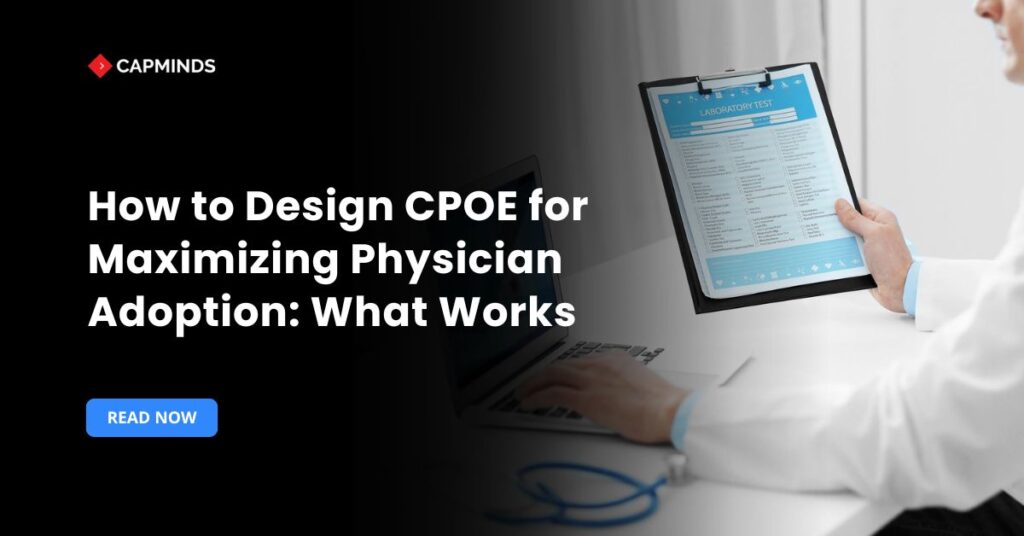How to Design CPOE for Maximizing Physician Adoption: What Works
Health systems have sought technological solutions to reduce medical mistakes. Computerized Physician Order Entry (CPOE) is one such tool: an electronic system that lets clinicians enter orders for medications and services with built-in decision rules to cut errors.
In practice, CPOE has shown clear safety benefits, for example, dramatically reducing medication errors from illegible handwriting, incorrect doses, allergies, duplicate therapies, and other issues.
Studies suggest moving from paper to CPOE can lower drug error rates by up to 80% when well implemented. Yet despite these advantages, adoption has lagged: historically, only a small fraction of U.S. hospitals and practices reached meaningful CPOE use (often well under 16%).
Achieving physician buy-in is critical because doctors are the primary order-writers. This blog identifies the key stakeholders and their pain points and then outlines evidence-based design and implementation strategies that help CPOE “work” in the real world.
Key Stakeholders and Their Pain Points
1. Physicians
The main users of CPOE. Doctors want an ordering process that is fast, intuitive, and aligned with their clinical workflow.
Common frustrations include slow systems with numerous clicks, intrusive alerts, and a lack of control over how orders are processed. In some cases, providers fear that rigid screens will slow them down or impinge on their clinical autonomy.
- At the same time, physicians stand to benefit from clearer data\ and embedded checks that improve safety.
- Studies consistently find that technical and design issues are the biggest factors influencing whether doctors use CPOE.
- Physicians also value the ability to tailor tools to their specialty; one review noted that doctors want CPOE features customizable to their department’s needs.
2. Nurses and Clinical Staff
Nurses and unit clerks carry out many ordered treatments and labs. Under paper systems, they often tracked orders manually and coordinated communications; a sudden shift to CPOE can disrupt these roles.
- For example, one study found that hospital unit clerks lost visibility into orders when hospitals moved to CPOE, changing their workflow markedly.
- Nurses need the system to integrate smoothly so that critical information is still communicated clearly.
- Slow or confusing electronic orders can add work for nursing staff and potentially delay care.
3. Pharmacists
Pharmacists rely on accurate medication orders.
They often face illegible or incomplete orders in paper charts. For them, CPOE can be a huge win: electronic orders force complete information and can automatically flag errors.
Well-designed CPOE with embedded drug libraries and decision support catches problems before orders reach the pharmacy, improving turnaround time and safety.
Pharmacists’ pain points arise when CPOE delivers too many irrelevant warnings or when order details are hard to interpret in the system, issues addressed by good alert design.
4. Hospital Administrators and Quality Leaders
Administrators and quality/safety officers champion CPOE for its population-level benefits. They face pressure to meet regulatory standards and to improve metrics. They worry about costs and project risk, but also about the failure of poorly adopted systems.
- Importantly, CPOE is often designated as a “Meaningful Use” technology by regulators, so its adoption is tied to financial incentives.
- Research shows that if implemented properly (with training and decision support), CPOE can cut medication errors by 17–81%, a powerful selling point.
- Administrators’ concerns, budgets, staffing, ROI, and reporting must be addressed, but their support is vital.
In sum, all these stakeholders should be engaged. Best-practice guidance emphasizes multidisciplinary teams for CPOE projects. Many hospitals have formed clinical steering committees that include physicians, nurses, pharmacists, IT staff, and executives.
These committees guide the project, resolve issues, and champion the system. The inclusion of frontline clinicians in planning and customization builds buy-in and ensures the system meets real needs.
Designing CPOE for Adoption
To win physician adoption, CPOE must be designed and implemented with users in mind. The following principles make CPOE more likely to succeed:
1. Workflow Integration and Process Redesign
Map and redesign clinical workflows before automation. Successful projects start with a detailed analysis of how orders are currently placed, processed, and acted upon. Process diagrams or flowcharts can help clinicians and IT visualize the “current state” and the “future state” under CPOE.
In every case study, teams invested heavily in process redesign during planning. They found that identifying and fixing inefficiencies before going live prevented many problems.
- If orders were getting misplaced under paper, the team found a better electronic notification pathway; if a junior doctor used shortcuts in the paper, the team created a similar shortcut in CPOE.
- A core AHRQ lesson: “Do not automate a manual process that does not work.”
- Engage clinicians, clerks, and nurses in this mapping so the new CPOE aligns with daily practice.
2. User-Centered Interface Design
Make the interface intuitive and efficient. Physicians will only adopt CPOE if the screens feel natural and do not slow them down.
Key design aspects include clear labeling, logical screen layouts, and minimal required clicks.
- Related fields should be grouped consistently, and common order elements should appear in the same place on each form.
- Dropdown menus, icons, and visual cues should follow human factors’ best practices so that physicians can scan and navigate easily.
- Provide quick-access lists of favorite orders or templates, allow copying of previous orders, and support auto-complete for drug names.
- Usability studies find that subtle design choices, such as how fields are arranged and how data is entered, can significantly affect CPOE adoption and error rates.
- Keep screens uncluttered and use sensible defaults.
- One AHRQ recommendation was to “minimize the amount of order details a user must complete, utilize default values where appropriate, and standardize placement of similar elements”.
- Defaults can speed common orders, but teams noted it’s important not to overuse them to avoid confusion.
3. Smart Clinical Decision Support and Alerts
Embed intelligent support, without causing alert fatigue. One advantage of CPOE is built-in decision support like drug allergy alerts, dose checks, and care guidelines.
- These alerts should help physicians catch errors or follow best practices.
- However, poorly tuned alerts can backfire: too many or irrelevant warnings will irritate doctors and may be ignored.
- To strike the right balance, design the CDS rules thoughtfully.
A hospital might start with only high-severity alerts enabled while suspending low-risk drug-interaction alerts until later.
AHRQ guides note that even with careful setup, some “alert fatigue” is unavoidable, so the hospital must monitor and adjust rules post-implementation.
- One strategy is to have a dedicated staff member or team round with clinicians during go-live to note alerts that cause frustration.
- Through iterative review, the CDS can be refined.
- The goal is to make alerts worth seeing: when a warning pops up, the doctor should feel it’s clinically important.
- Done right, decision support helps physicians by delivering relevant, patient-specific guidance at the point of order, reinforcing adherence to protocols, and reducing oversight.
4. Customizable Order Sets and Templates
Use standardized order sets, tailored by specialty. To simplify ordering, many CPOE systems use order sets: pre-defined groups of orders for common conditions.
Building these sets is labor-intensive but pays off in adoption. Hospitals often dedicate months to developing hundreds of custom order sets, involving clinicians from every department.
Each physician group should see its usual orders in a template, with default values and checklists already filled in. This reduces data entry and cognitive load. Importantly, physicians should have the ability to modify or choose different sets to fit their style.
- Studies show clinicians will use the system more if they feel it’s adapted to their practice, for example, allowing an ICU doctor to suppress pediatric dose options, or letting a surgeon pick favorite antibiotic orders.
- Consistency also helps: within an order set, place similar fields in fixed positions across all sets to avoid confusion.
5. Comprehensive Training and Change Management
Prepare clinicians with hands-on training and ongoing support. Even the best system will fail if users aren’t comfortable. AHRQ projects emphasize training all staff well before going live.
This includes technical basics and explaining why workflows are changing. It’s often recommended to identify “super-users”, enthusiastic clinicians who can lead peer training and help colleagues.
- Utilizing a demo environment or “sandbox” can greatly help: one hospital set up a separate CPOE test system where doctors could practice entering orders without affecting real patients.
- In these playgrounds, just-in-time training helped refresh skills. Expect to devote substantial hours: some centers logged thousands of training hours to get physicians ready.
- Also, plan for retraining. For instance, part-time hospitalists or consulting physicians may use the inpatient CPOE only occasionally, so they need regular refreshers or just-in-time coaching to regain proficiency.
- Crucially, ensure ample technical support during and after go-live.
- Many hospitals staffed 24×7 help desks and “floated” IT experts on units for weeks after rollout.
- Rapid issue resolution prevents frustration and workaround habits.
Daily tip sheets or bulletin updates can reinforce best practices during the transition.
6. Governance and Continuous Improvement
Maintain oversight and iterate on feedback. CPOE implementation doesn’t end at go-live. As Khanna & Yen note, every rollout involves complex local factors and culture. A best practice is to keep the steering committee and champions active after launch. These groups can meet periodically to review usage data, discuss user feedback, and approve modifications.
For example, collect metrics on order completion times or alert override rates, and follow up on bottlenecks. Make it easy for physicians to suggest improvements.
AHRQ-funded projects tracked order patterns and clinician reports daily in the first weeks. If an alert triggers too often and is dismissed without action, refine its logic. If providers consistently struggle with a particular order set, revise it in consultation with clinicians.
- This ongoing optimization builds trust: staff see that their concerns lead to real changes. In effect, CPOE becomes a continuously evolving tool.
- Finally, remember to communicate wins: share how order entry efficiency or safety metrics improve, reinforcing to stakeholders that the effort is paying off.
Transform CPOE Success Into Sustainable Digital Health Wins
CapMinds helps healthcare organizations design and implement CPOE systems that physicians want to use by making them intuitive, smart, and specialty-focused.
If you’re investing in safer, faster clinical workflows, our complete digital health tech solutions ensure your implementation succeeds from day one.
Here’s how we support your transformation:
- CPOE Design & Implementation – Tailored to specialty workflows with smart alerts and clinical decision support
- Custom EHR Integration – Seamless data flow between CPOE, labs, pharmacy, and billing
- Clinical Decision Support Systems – Reduce errors with intelligent, non-intrusive alerts
- User-Centered UI/UX Development – Designed with frontline physicians in mind
- Training & Change Management – Super-user strategy, sandbox environments, and go-live support
- Ongoing Optimization & Governance – Post-launch enhancements with data-driven iteration
Whether you’re planning your first rollout or optimizing an existing system, CapMinds is your trusted partner for smarter, safer, and scalable healthcare IT.
Contact us and let’s discuss your CPOE goals and how we can help you achieve them faster.




